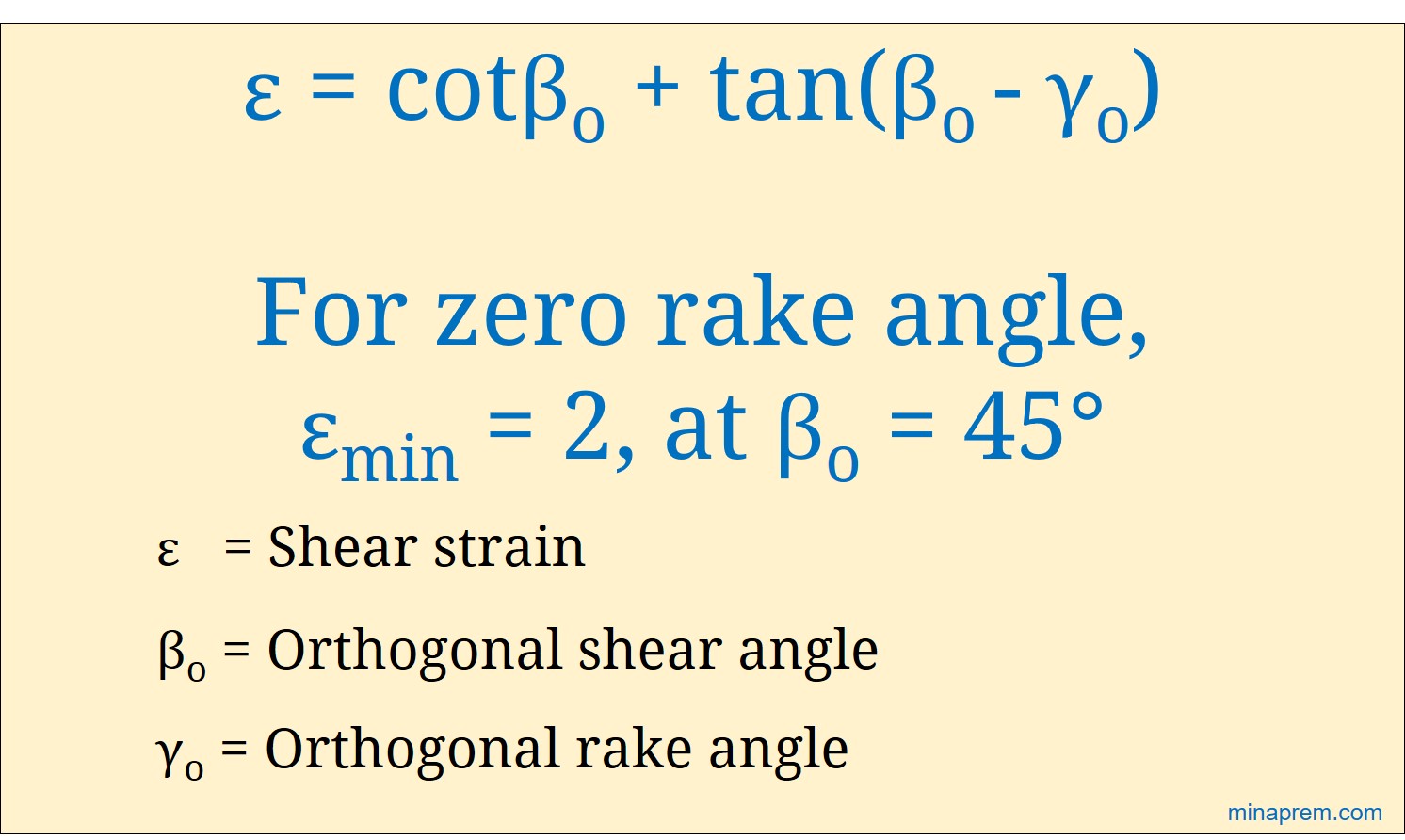Question: Determine the theoretically minimum possible shear strain in orthogonal turning with a cutting tool of zero orthogonal rake angle. [ESE 2009]
Solution: Metal cutting processes are employed to remove excess material from workpiece to impart desired shape and finish. This material removal takes place by shearing when a wedge shaped cutting tool compresses a layer of workpiece material. The cutting strain developed due to shearing is termed as shear strain in machining. This shear strain (ε) in orthogonal machining can be expressed easily in terms of orthogonal shear angle (βO) and orthogonal rake angle (γO) of the cutting tool, as given below.
\[\varepsilon = \cot {\beta _o} + \tan ({\beta _o} – {\gamma _o})\]

The objective now is to calculate theoretically minimum possible shear strain. In this particular case, rake angle (γO) is given as zero. Substituting γO = 0°, the above expression for shear strain can be reduced to its simplest form as given below.
\[\varepsilon = \cot {\beta _o} + \tan {\beta _o}\]
In this expression, the only variable is the orthogonal shear angle (βO). In order to find out minimum shear strain (ε), let us first find out first order differentiation and second order differentiation of ε with respect to βO.
First order differentiation:
\[\frac{{d\varepsilon }}{{d{\beta _o}}} = \frac{d}{{dx}}\left( {\frac{2}{{\sin 2{\beta _o}}}} \right)\]
\[\frac{{d\varepsilon }}{{d{\beta _o}}} = \frac{{0 – 2.2.\cos 2{\beta _o}}}{{{{\left( {\sin 2{\beta _o}} \right)}^2}}}\]
\[\frac{{d\varepsilon }}{{d{\beta _o}}} = – \frac{{4\cos 2{\beta _o}}}{{{{\left( {\sin 2{\beta _o}} \right)}^2}}}\]
Second order differentiation:
\[\frac{{{d^2}\varepsilon }}{{d{\beta _o}^2}} = – \frac{{{{\left( {\sin 2{\beta _o}} \right)}^2}\left( { – 8\sin 2{\beta _o}} \right) – \left( {4\cos 2{\beta _o}} \right)\left( {4\cos 2{\beta _o}\sin 2{\beta _o}} \right)}}{{{{\left( {\sin 2{\beta _o}} \right)}^4}}}\]
\[\frac{{{d^2}\varepsilon }}{{d{\beta _o}^2}} = \frac{{8{{\left( {\sin 2{\beta _o}} \right)}^2} – 16{{\left( {\cos 2{\beta _o}} \right)}^2}}}{{{{\left( {\sin 2{\beta _o}} \right)}^3}}}\]
Shear angle for minimum cutting strain
Now for the shear strain to be either minimum or maximum, the first order derivative has to be zero. Substituting the (dε/dβo) = 0, the following can be found.
\( – \frac{{4\cos 2{\beta _o}}}{{{{\left( {\sin 2{\beta _o}} \right)}^2}}} = 0\)
or, \(\cos 2{\beta _o} = 0\)
or, \(\cos 2{\beta _o} = \cos 90\) [∵ 0° < βo < 90°]
or, \({\beta _o} = 45\)
Checking whether minimum or maximum
Now the shear strain (ε) will be minimum if the value of second order derivative (d2ε/dβo2) at βo = 45° is greater than 0 (i.e. positive). If it is negative then ε will have maximum value at βo = 45°. So let us calculate (d2ε/dβo2) value at βo = 45° using the expression derived earlier for second order differentiation.
\[\frac{{{d^2}\varepsilon }}{{d{\beta _o}^2}} = \frac{{8{{\left( {\sin 90} \right)}^2} – 16{{\left( {\cos 90} \right)}^2}}}{{{{\left( {\sin 90} \right)}^3}}}\]
\[\frac{{{d^2}\varepsilon }}{{d{\beta _o}^2}} = \frac{{8 – 0}}{1} = 8 > 0\]
Value of minimum shear strain
Hence, shear strain (ε) is minimum at the shear angle of βo = 45°, when orthogonal rake angle of the cutting tool is zero. The value of this minimum shear strain (εmin) can be calculated easily from the basic expression of shear strain as mentioned at the beginning. Minimum shear strain in this case is 2.0 as calculated below:
\({\varepsilon _{\min }} = \cot 45 + \tan 45\)
\({\varepsilon _{\min }} = 1 + 1 = 2\)
It is worth mentioning that minimum shear strain (εmin) will deviate from this value if orthogonal rake angle (γo) of the cutting tool is not zero (γO ¹ 0°). Since rake angle can be either negative, zero or positive, so separate but similar calculation is desired to get minimum shear strain for non-zero rake angle.